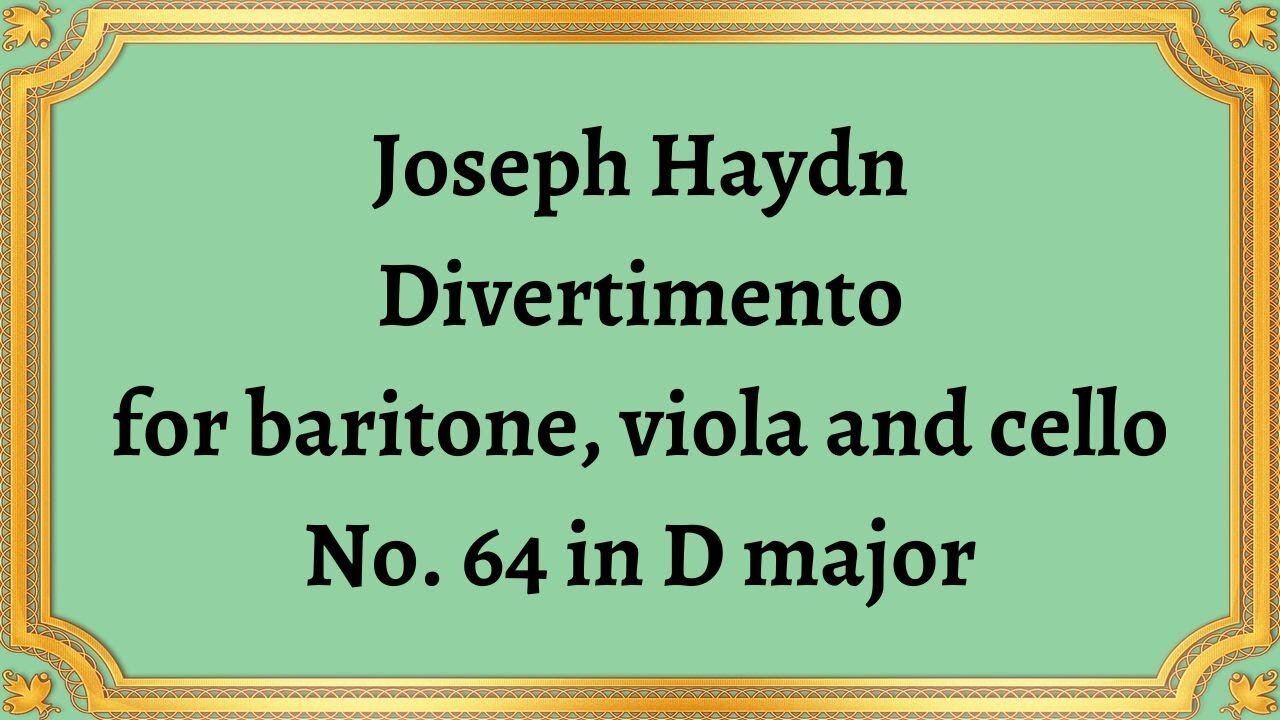Premium Only Content

Joseph Haydn Divertimento for baritone, viola and cello No. 64 in D major
#JosephHaydn #Divertimento #Baritone #Viola #Cello #Dmajor #chambermusic #Adagio #Menuetto #Allegro #classicalmusic #baryton #instrumentation #musiccomposition #ChamberMusicRepertoire
Joseph Haydn, one of the most renowned classical composers, wrote more than 100 divertimentos. The Divertimento for Baritone, Viola, and Cello No. 64 in D major stands out as a unique composition in the chamber music repertoire. It features a rare instrument, the baryton, which Haydn often used to create unique and complex melodies.
The Divertimento for Baritone, Viola, and Cello No. 64 in D major was composed in 1773 upon the request of Prince Nikolaus Esterhazy for his baryton-playing ensemble. The work's instrumentation includes baritone, viola, and cello. Unlike most of his compositions, Haydn used the unusual tuning of the baryton to create a rich tonal palette. The baryton has a set of wire strings on the back of the fingerboard, which when plucked by the left hand produce a unique sound that adds to the piece's texture.
The first movement of the Divertimento is marked as Adagio, which means slowly. The opening melody is played by the viola, interweaving with the cello and baritone in the background. The soaring, and at times, melancholic melody, creates an appreciable ambience. The second movement, marked as Menuetto, is in a 3/4 meter, with a more rhythmic and upbeat feel. As the name suggests, this movement presents a pleasant dance-like style. The trio section of the Menuetto is scored for the baritone and viola in a duet with the cello providing an accompaniment. The final movement, marked as Allegro, is the most technically demanding section of the Divertimento, with the baryton and viola carrying the melody, and the cello providing a rich harmonic foundation. Haydn's use of the baryton in this work is exceptional, as it produces a sound that is not found in any other chamber music composition.
Joseph Haydn's Divertimento for Baritone, Viola, and Cello No. 64 in D major is a significant contribution to the chamber music literature. The composer's ability to create a rich texture using a rarely heard instrument such as the baryton is evident in this composition. Haydn's music has endured centuries, and it's exciting to listen to how he blends the tones from different instruments, creating works that continue to enthrall audiences today.
You have the opportunity to support the channel https://destream.net/live/RadSiarAl/donate
-
 2:01:47
2:01:47
Nerdrotic
14 hours ago $14.39 earnedEgypt, Peru and Guatemala Luke Caverns RETURNS! | Forbidden Frontier #082
86.1K10 -
 LIVE
LIVE
Vigilant News Network
14 hours agoFDA Approves Trials for New “Pandemic” Vaccine | Media Blackout
1,945 watching -
 4:06:21
4:06:21
GamerGril
15 hours agoIM THE GREASTEST OF ALL TIME AT.... CHAOS | DAYS GONE
124K12 -
 3:00:18
3:00:18
Due Dissidence
1 day agoTHE PEOPLE VS NATURE by Kevin Augustine - plus a talkback w/ Jimmy Dore
141K22 -
 6:02:06
6:02:06
Rotella Games
20 hours agoMake the Hood Great Again | Day 3 | GTA San Andreas
93.6K6 -
 2:50:48
2:50:48
PudgeTV
20 hours ago🟡 Practical Pudge Ep 48 with "Willie Faulk" | Catching Up With Old Friends
81.4K3 -
 18:32
18:32
Forrest Galante
1 day ago5 Extinct Animals That I Believe Could Still Be Alive...
183K39 -
 DVR
DVR
Major League Fishing
3 days agoLIVE! - General Tire Team Series: Summit Cup - Day 1
169K7 -
 7:05:23
7:05:23
Hevel Gaming
1 day ago $70.20 earnedNCAAF Tennessee at Georgia While with Heroes of Might and Magic III & Helldivers 2
263K26 -
 6:34:08
6:34:08
MissesMaam
1 day agoI'm Addicted | Sons of the Forest 💚✨
199K32